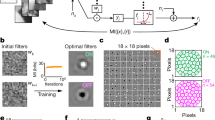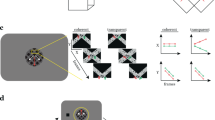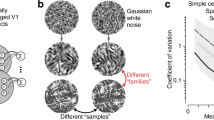Abstract
Recently, interest has revived in the classical problems of vernier and stereoscopic acuity. The precision with which observers can align two bars in a vernier task is as high as 2 sec arc, which is much finer than the grain of the retinal receptor mosaic, where the cones are separated by 20–30 sec arc even at their most densely packed. Thus, it seems that the visual system may be able to interpolate between the discrete samples provided by the retinal mosaic; recently, several possible mechanisms have been proposed1,2. Mathematically there is no mystery about interpolation. The optical system of the eye acts as a low-pass filter removing all frequencies above ∼60 cycles deg−1, so it follows from the sampling theorem that the retinal image can be fully represented by sampling at a frequency of 120 cycles deg−1, which is approximately that of the receptor mosaic. In principle, therefore, discrete sampling by the retinal mosaic does not remove information from the image. Indeed, the low-pass filtering action of the eye implies that acuity would not be lost, even if the signal itself were divided into discrete samples, before observation. We report here that human observers can locate the spatial position of a periodic visual pattern with a precision as high as 5–10 sec arc, even though the pattern is coarsely sampled at an interval over 10 times that amount. This suggests that the human visual system can construct a surprisingly accurate representation of a pattern from discrete samples, despite the samples being sufficiently widely spaced to be visually resolved.
This is a preview of subscription content, access via your institution
Access options
Subscribe to this journal
Receive 51 print issues and online access
$199.00 per year
only $3.90 per issue
Buy this article
- Purchase on Springer Link
- Instant access to full article PDF
Prices may be subject to local taxes which are calculated during checkout
Similar content being viewed by others
References
Ditchburn, R. W. Eye Movements and Visual Perception (Clarendon, Oxford, 1973).
Barlow, H. B. Nature 279, 189–191 (1979).
Nyman, G. & Laurinen, P. Nature 297, 324–325 (1982).
Watt, R. J. & Andrews, D. P. Curr. Psychol. Rev. 1, 205–214 (1981).
Wilson, H. R. & Bergen, J. R. Vision Res. 19, 19–32 (1979).
Marr, D. & Hildreth, E. Proc. R. Soc. B207, 187–217 (1980).
Author information
Authors and Affiliations
Rights and permissions
About this article
Cite this article
Morgan, M., Watt, R. Mechanisms of interpolation in human spatial vision. Nature 299, 553–555 (1982). https://doi.org/10.1038/299553a0
Received:
Accepted:
Issue Date:
DOI: https://doi.org/10.1038/299553a0
This article is cited by
-
Stereo disparity computation using Gabor filters
Biological Cybernetics (1988)
-
A self-similar stack model for human and machine vision
Biological Cybernetics (1986)
Comments
By submitting a comment you agree to abide by our Terms and Community Guidelines. If you find something abusive or that does not comply with our terms or guidelines please flag it as inappropriate.



